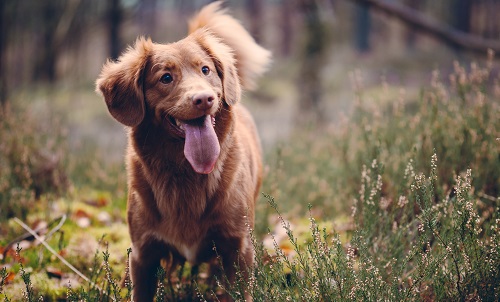Canine influenza, also called dog flu, is a highly contagious viral infection that affects dogs as well as cats. There are no reported cases of dog flu in humans. The first recognized cases of canine influenza occurred in January of 2004, at a greyhound racing facility in Florida. This outbreak was later identified as H3N8, which is one of two recognized strains of dog flu present in the United States. The other is H3N2, which was responsible for a 2015 outbreak that affected Chicago dog boarding facilities. In this article, we will outline the dangers of this condition, and tell you what you need to know regarding the canine influenza vaccine. Read on for more!
Transmission and Symptoms
Dog flu is an ‘airborne’ virus which travels from one dog to another via canine coughing, sneezing, and barking. The virus can live for 24-48 hours on human clothes, skin, and other surfaces – so direct contact with an infected dog is not necessary for contraction. While any dog can contract canine influenza, dogs in boarding facilities, shelters, and daycares are at much higher risk.
Canine influenza is still relatively rare, and it shares symptoms with many other canine respiratory illnesses. For these reasons, dog flu cannot be diagnosed based solely on the outlined canine influenza symptoms. If dog flu is suspected, a test can confirm the diagnosis. Canine influenza symptoms include coughing, sneezing, fatigue, dehydration, fever, and nasal discharge. The severity of symptoms varies, and while nearly all dogs recover from canine influenza, the H3N2 strain is responsible for at least a handful of deaths in the United States.
Treatment and Non-Vaccination Prevention
 If a dog is unfortunate enough to contract canine influenza, treatment is usually focused on supporting the pup’s natural immune response. Helping the dog get proper rest and nutrition, as well as adequate fluids, is usually enough to help their body fight the illness on its own. Typically, symptoms dissipate within two to three weeks. In rare, more severe cases, pneumonia and secondary bacterial infections may develop, necessitating further treatment.
If a dog is unfortunate enough to contract canine influenza, treatment is usually focused on supporting the pup’s natural immune response. Helping the dog get proper rest and nutrition, as well as adequate fluids, is usually enough to help their body fight the illness on its own. Typically, symptoms dissipate within two to three weeks. In rare, more severe cases, pneumonia and secondary bacterial infections may develop, necessitating further treatment.
Prevention of canine influenza involves strict cleaning and disinfecting protocols in dog boarding and veterinary facilities. The virus can be killed easily with disinfectants, so employees should disinfect the entire facility at least once per day to ensure that canine influenza is not actively living on any surfaces. In veterinary clinics, dogs showing signs of respiratory illness should not be allowed in the waiting room. Additionally, any dog actively showing signs of respiratory illness should be quarantined for four weeks to prevent spreading of the virus.
Should my Dog be Vaccinated for Canine Influenza?
It is highly unlikely that your dog will contract canine influenza if he does not spend time in daycares, boarding, or grooming facilities. The vaccine is not recommended for dogs who do not fall into this category.
If you do board your dog in these facilities, be adamant about checking with the facility to learn about the precautionary measures they take. All dog boarding businesses should be extremely rigorous about disinfecting their facilities and scrupulously checking for any signs of respiratory illness in dogs. Fortunately, due to the pervasiveness of kennel cough and the similarities in symptoms and ways it spreads, most facilities do take such precautions. Still, as a responsible dog owner, you should always confirm with the facility that they take all possible measures.
 In 2009, the first canine influenza vaccine was released in the United States to prevent H3N8, since that was the only strain present at the time. With the recent Chicago introduction and outbreak of H3N2, there are now vaccines available to prevent either or both strains. Healthy dogs and puppies seven weeks of age or more are viable candidates for the vaccination. The canine influenze vaccine schedule is two injections administered two-to-four weeks apart for the H3N2 and H3N8 combined vaccination. Annual revaccination is essential.
In 2009, the first canine influenza vaccine was released in the United States to prevent H3N8, since that was the only strain present at the time. With the recent Chicago introduction and outbreak of H3N2, there are now vaccines available to prevent either or both strains. Healthy dogs and puppies seven weeks of age or more are viable candidates for the vaccination. The canine influenze vaccine schedule is two injections administered two-to-four weeks apart for the H3N2 and H3N8 combined vaccination. Annual revaccination is essential.
Many veterinarians do not stock the canine influenza vaccination because the virus is still relatively rare in the United States. If you have reason to believe that you should vaccinate your dog, ask your vet to order the vaccination. It must be administered at least two weeks prior to exposure to be effective.
Remember, vaccinated dogs can still become infected with canine influenza. While the vaccine does prevent contraction in many cases, its purpose is to reduce the severity, duration, and contagiousness of infected dogs in order to control the spread of the virus. Always check with your veterinarian to see whether they recommend the canine influenza vaccine for your dog. It is their responsibility to stay up-to-date on latest outbreaks and vaccination updates, but always cross-check their insights with your dog boarding facility to ensure you are doing the right thing.
Sources:
“Canine Influenza Vaccination: Does Your Dog Need It?” PetMD, Accessed 15 Oct. 2018. www.petmd.com/news/view/canine-influenza-vaccination-does-your-dog-need-it-35403.
“Canine Influenza.” Avma.org, Accessed 15 Oct. 2018. www.avma.org/KB/Resources/Reference/Pages/Canine-Influenza-Backgrounder.aspx.
“Key Facts about Canine Influenza (Dog Flu) | Seasonal Influenza (Flu) | CDC.” Centers for Disease Control and Prevention, Accessed 15 Oct. 2018. www.cdc.gov/flu/other/canine-flu/keyfacts.html.




